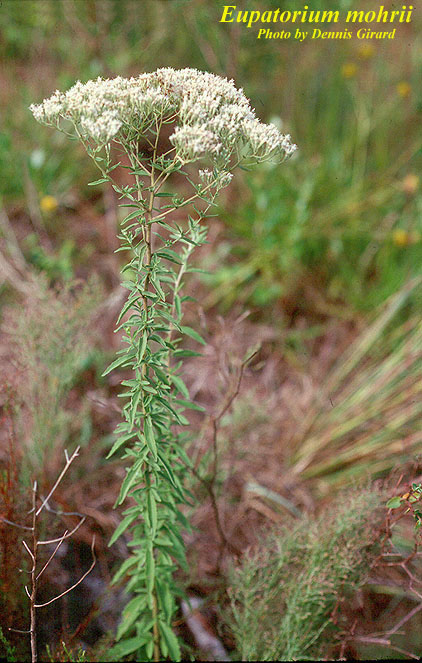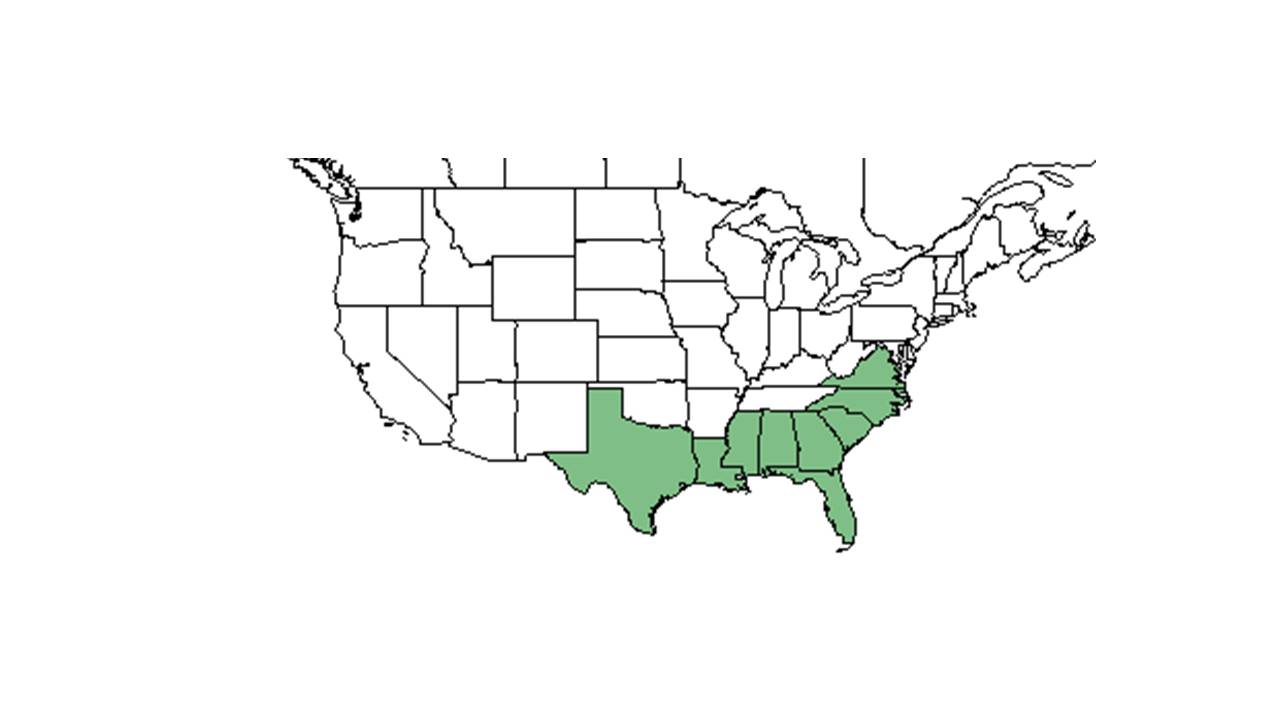Difference between revisions of "Eupatorium mohrii"
Krobertson (talk | contribs) |
Krobertson (talk | contribs) |
||
| Line 28: | Line 28: | ||
==Ecology== | ==Ecology== | ||
===Habitat=== <!--Natural communities, human disturbed habitats, topography, hydrology, soils, light, fire regime requirements for removal of competition, etc.--> | ===Habitat=== <!--Natural communities, human disturbed habitats, topography, hydrology, soils, light, fire regime requirements for removal of competition, etc.--> | ||
| − | It does well in open canopy areas on longleaf pine habitats. Does not do well in highly disturbed areas (such as clear cutting)<ref>Brockway, D. G. and C. E. Lewis (2003). "Influence of deer, cattle grazing and timber harvest on plant species diversity in a longleaf pine bluestem ecosystem." Forest Ecology and Management 175: 49-69.</ref> It is found areas that have become wet in some parts of the year such as in slash pine flatwoods, hammocks, near creeks, pond-pine scrubs, peaty pine savannas, wet flatwwods, swampy depressions between sand ridges, pine-palmetto flatwoods, upper edges of hilldside bogs, edges of titi bogs, swales and dunes, and in river floodplains. It is also found in human disturbed areas such as pinelands that have been clear cut, along roadside depressions, embankments, edges of an artificial pond, and in powerline corridors. It is associated with areas that have moist soil, moist sandy peaty soil, semi-wet soil, muckly aulluvium soils, and moist sandy clay<ref name=fsu>Florida State University Robert K. Godfrey Herbarium database. URL: http://herbarium.bio.fsu.edu. Last accessed: June 2014. Collectors: R.K. Godfrey, Loran C. Anderson, A. F. Clewell, Clarke Hudson, R.L. Lazor, J. P. Gillespie, D. S. Correll, P. L. Redfearn, Jr., Sid McDaniel, J. Lazor, Jean W. Wooten, V. I. Sullivan, J. Britten, B. K. Holst, Cruz, Montero, C. Jackson, R. Kral, Roomie Wilson, B F Hansen, JoAnn Hansen, Carol Havlik, Ann F. Johnson, Chet Winegarner, Marsha Winegarner, S. C. Hood, R. A. Norris, R. Komarek, and Annie Schmidt. States and Counties:Florida: Bay, Brevard, Citrus, Clay, Columbia, Dixie, Flagler, Franklin, Gulf, Hamilton, Holmes, Jefferson, Leon, Levy, Liberty, Martin, Okaloosa, Putnam, Santa Rosa, Sarasota, St. John’s, Suwannee, Taylor, Union, Wakulla, Walton, and Washington. Georgia: Atkinson, Brantley, Camden, Charlton, Clinch, Decatur, Echols, Grady, Thomas, and Ware.</ref> | + | It does well in open canopy areas on longleaf pine habitats. Does not do well in highly disturbed areas (such as clear cutting)<ref>Brockway, D. G. and C. E. Lewis (2003). "Influence of deer, cattle grazing and timber harvest on plant species diversity in a longleaf pine bluestem ecosystem." Forest Ecology and Management 175: 49-69.</ref> It is found areas that have become wet in some parts of the year such as in slash pine flatwoods, hammocks, near creeks, pond-pine scrubs, peaty pine savannas, wet flatwwods, swampy depressions between sand ridges, pine-palmetto flatwoods, upper edges of hilldside bogs, edges of titi bogs, swales and dunes, and in river floodplains. It is also found in human disturbed areas such as pinelands that have been clear cut, along roadside depressions, embankments, edges of an artificial pond, and in powerline corridors. It is associated with areas that have moist soil, moist sandy peaty soil, semi-wet soil, muckly aulluvium soils, and moist sandy clay.<ref name=fsu>Florida State University Robert K. Godfrey Herbarium database. URL: http://herbarium.bio.fsu.edu. Last accessed: June 2014. Collectors: R.K. Godfrey, Loran C. Anderson, A. F. Clewell, Clarke Hudson, R.L. Lazor, J. P. Gillespie, D. S. Correll, P. L. Redfearn, Jr., Sid McDaniel, J. Lazor, Jean W. Wooten, V. I. Sullivan, J. Britten, B. K. Holst, Cruz, Montero, C. Jackson, R. Kral, Roomie Wilson, B F Hansen, JoAnn Hansen, Carol Havlik, Ann F. Johnson, Chet Winegarner, Marsha Winegarner, S. C. Hood, R. A. Norris, R. Komarek, and Annie Schmidt. States and Counties:Florida: Bay, Brevard, Citrus, Clay, Columbia, Dixie, Flagler, Franklin, Gulf, Hamilton, Holmes, Jefferson, Leon, Levy, Liberty, Martin, Okaloosa, Putnam, Santa Rosa, Sarasota, St. John’s, Suwannee, Taylor, Union, Wakulla, Walton, and Washington. Georgia: Atkinson, Brantley, Camden, Charlton, Clinch, Decatur, Echols, Grady, Thomas, and Ware.</ref> |
Associated species include ''Eupatorium rotundifolium, E. album, E. cuneifolium, E. leucolepis, E. recurvans, E. mikaniodes, Andropogon, Aster dumosus, Ludwigia virgata, Carex joorii, Panicum rigidulum, Rhexia mariana, Rubus cuneifolius, Magnolia virginina, Pinus palutris, P. elliottii, P. taeda, Serenoa repens, Aristida stricta, Quercus, Liquidambar styraciflua, Cyrilla racemiflora''<ref name=fsu/>. | Associated species include ''Eupatorium rotundifolium, E. album, E. cuneifolium, E. leucolepis, E. recurvans, E. mikaniodes, Andropogon, Aster dumosus, Ludwigia virgata, Carex joorii, Panicum rigidulum, Rhexia mariana, Rubus cuneifolius, Magnolia virginina, Pinus palutris, P. elliottii, P. taeda, Serenoa repens, Aristida stricta, Quercus, Liquidambar styraciflua, Cyrilla racemiflora''<ref name=fsu/>. | ||
| + | |||
===Phenology=== <!--Timing off flowering, fruiting, seed dispersal, and environmental triggers. Cite PanFlora website if appropriate: http://www.gilnelson.com/PanFlora/ --> | ===Phenology=== <!--Timing off flowering, fruiting, seed dispersal, and environmental triggers. Cite PanFlora website if appropriate: http://www.gilnelson.com/PanFlora/ --> | ||
Native, perennial herb in longleaf pine stands.<ref>Harrington, T. B. (2011). "Overstory and understory relationships in longleaf pine plantations 14 years after thinning and woody control." Canadian Journal of Forest Research 41: 2301-2314.</ref> It has been observed flowering from June to October<ref name=fsu/>. | Native, perennial herb in longleaf pine stands.<ref>Harrington, T. B. (2011). "Overstory and understory relationships in longleaf pine plantations 14 years after thinning and woody control." Canadian Journal of Forest Research 41: 2301-2314.</ref> It has been observed flowering from June to October<ref name=fsu/>. | ||
Revision as of 12:31, 17 August 2016
| Eupatorium mohrii | |
|---|---|

| |
| Photo by Dennis Girard, Atlas of Florida Vascular Plants | |
| Scientific classification | |
| Kingdom: | Plantae |
| Division: | Magnoliophyta - Flowering plants |
| Class: | Magnoliopsida – Dicotyledons |
| Order: | Asterales |
| Family: | Asteraceae ⁄ Compositae |
| Genus: | Eupatorium |
| Species: | E. mohrii |
| Binomial name | |
| Eupatorium mohrii Greene | |

| |
| Natural range of Eupatorium mohrii from USDA NRCS Plants Database. | |
Common name: Mohr's thoroughwort
Contents
Taxonomic notes
Synonym: Eupatorium recurvans Small
Description
A description of Eupatorium mohrii is provided in The Flora of North America.
Distribution
Ecology
Habitat
It does well in open canopy areas on longleaf pine habitats. Does not do well in highly disturbed areas (such as clear cutting)[1] It is found areas that have become wet in some parts of the year such as in slash pine flatwoods, hammocks, near creeks, pond-pine scrubs, peaty pine savannas, wet flatwwods, swampy depressions between sand ridges, pine-palmetto flatwoods, upper edges of hilldside bogs, edges of titi bogs, swales and dunes, and in river floodplains. It is also found in human disturbed areas such as pinelands that have been clear cut, along roadside depressions, embankments, edges of an artificial pond, and in powerline corridors. It is associated with areas that have moist soil, moist sandy peaty soil, semi-wet soil, muckly aulluvium soils, and moist sandy clay.[2]
Associated species include Eupatorium rotundifolium, E. album, E. cuneifolium, E. leucolepis, E. recurvans, E. mikaniodes, Andropogon, Aster dumosus, Ludwigia virgata, Carex joorii, Panicum rigidulum, Rhexia mariana, Rubus cuneifolius, Magnolia virginina, Pinus palutris, P. elliottii, P. taeda, Serenoa repens, Aristida stricta, Quercus, Liquidambar styraciflua, Cyrilla racemiflora[2].
Phenology
Native, perennial herb in longleaf pine stands.[3] It has been observed flowering from June to October[2].
Pollination
The following Hymenoptera families and species were observed visiting flowers of Eupatorium mohrii at Archbold Biological Station: [4]
Apidae: Apis mellifera, Bombus impatiens
Halictidae: Agapostemon splendens, Halictus poeyi
Leucospididae: Leucospis robertsoni, L. slossonae
Megachilidae: Coelioxys mexicana, Dianthidium floridiense, Megachile albitarsis
Sphecidae: Bicyrtes capnoptera, B. insidiatrix, Cerceris blakei, Philanthus ventilabris, Prionyx thomae, Tachytes pepticus, T. validus
Vespidae: Pachodynerus erynnis
Conservation and management
Cultivation and restoration
Photo Gallery
References and notes
- ↑ Brockway, D. G. and C. E. Lewis (2003). "Influence of deer, cattle grazing and timber harvest on plant species diversity in a longleaf pine bluestem ecosystem." Forest Ecology and Management 175: 49-69.
- ↑ 2.0 2.1 2.2 Florida State University Robert K. Godfrey Herbarium database. URL: http://herbarium.bio.fsu.edu. Last accessed: June 2014. Collectors: R.K. Godfrey, Loran C. Anderson, A. F. Clewell, Clarke Hudson, R.L. Lazor, J. P. Gillespie, D. S. Correll, P. L. Redfearn, Jr., Sid McDaniel, J. Lazor, Jean W. Wooten, V. I. Sullivan, J. Britten, B. K. Holst, Cruz, Montero, C. Jackson, R. Kral, Roomie Wilson, B F Hansen, JoAnn Hansen, Carol Havlik, Ann F. Johnson, Chet Winegarner, Marsha Winegarner, S. C. Hood, R. A. Norris, R. Komarek, and Annie Schmidt. States and Counties:Florida: Bay, Brevard, Citrus, Clay, Columbia, Dixie, Flagler, Franklin, Gulf, Hamilton, Holmes, Jefferson, Leon, Levy, Liberty, Martin, Okaloosa, Putnam, Santa Rosa, Sarasota, St. John’s, Suwannee, Taylor, Union, Wakulla, Walton, and Washington. Georgia: Atkinson, Brantley, Camden, Charlton, Clinch, Decatur, Echols, Grady, Thomas, and Ware.
- ↑ Harrington, T. B. (2011). "Overstory and understory relationships in longleaf pine plantations 14 years after thinning and woody control." Canadian Journal of Forest Research 41: 2301-2314.
- ↑ Deyrup, M.A. and N.D. 2015. Database of observations of Hymenoptera visitations to flowers of plants on Archbold Biological Station, Florida, USA.